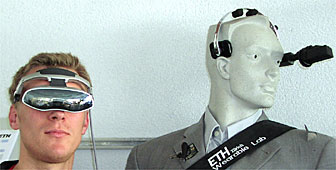Future of computing comes under scrutiny

Swiss technology experts have launched a study to assess the health and environmental risks posed by so-called "pervasive computing".
Pervasive computing, which includes wearable and injectable computers, is considered by experts to be the next step in the evolution of computer technology.
For TA-Swiss, the national technology assessment centre, its introduction raises more than a few questions.
“There will be no escaping the wireless world,” said Sergio Bellucci, director of TA-Swiss. “But we should look at the potential consequences.”
Pervasive computers can be extremely small – the size of a grain of rice – and can be embedded in almost any type of object. This includes cars, tools, appliances, clothing and consumer goods.
Wireless computing has already begun to make inroads on the Swiss market.
The Bluetooth standard, which is supported by major telecommunication equipment makers, already enables connections between portable electronic devices.
Wearable computers are still in the prototype stage, and more development will be required before they become truly user-friendly.
Injectable computers, on the other hand, are well into the production stage, even if their use is far from widespread, except as identification tags for animals.
But there is already talk of using these computers for tracking children, as well as for medical applications.
Increased radiation
Determining the effects of this new technology on people’s health may prove to be difficult.
The effect of low-level electromagnetic radiation on the human body, as found in mobile phones, is still the subject of much controversy.
The researchers carrying out the study says preliminary results show that the introduction of pervasive computing could lead to a hundred-fold increase in the number of electromagnetic sources.
“Most of this is low-level, so we expect just a low increase of overall electromagnetic radiation,” said Lorenz Hilty, the team’s leader.
However, the researchers insist they won’t be taking the issue lightly.
“There are some indications that there are some small effects on the human body, so the problem must be considered seriously,” added Hilty.
The issue of what impact pervasive computers will have on the environment is less controversial among scientists.
Recycling computers
The study is focusing on two aspects: the recycling of computer equipment and energy consumption.
“We have to see what the balance is between the advantages of this technology and the environmental problems it creates,” said Bellucci.
The researchers believe that the new technology will not increase the problems associated with disposing of computer equipment.
They do say, however, that power sources such as batteries, which will be used even more with pervasive computing, could constitute a major headache in the future.
“We will have to consider measures to deal with this issue in an environmentally-friendly way,” said Hilty.
Questions of privacy
The introduction of pervasive computing also raises ethical questions. As is often the case with computer technology, the spectre of Big Brother looms large.
So should restrictions be placed on the use of pervasive computers, particularly the exchange of data?
“There is definitely a question of privacy that is raised by this technology,” Bellucci told swissinfo.
“Part of our assessment is to make this kind of question as clear as possible, so society can make the best possible decision.”
“We all like to use technology. But we will have to eventually decide whether the benefits outweigh the disadvantages,” he added.
The final results of the TA-Swiss study will be published in early 2003.
swissinfo, Scott Capper
Pervasive computing includes computers, but also very small devices, either mobile or embedded in almost any type of object.
TA-Swiss is looking at the health and environmental effects of pervasive computing.
Experts expect there will be many more sources of electromagnetic radiation, but not a significant increase in overall radiation.

In compliance with the JTI standards
More: SWI swissinfo.ch certified by the Journalism Trust Initiative










You can find an overview of ongoing debates with our journalists here . Please join us!
If you want to start a conversation about a topic raised in this article or want to report factual errors, email us at english@swissinfo.ch.